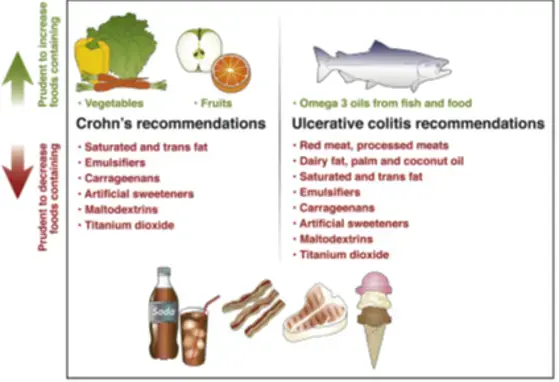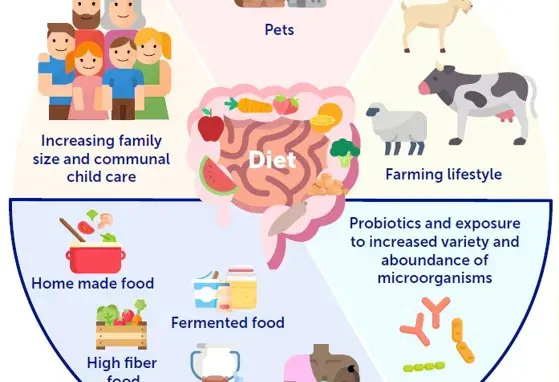Gut Microbiota
Microbiota describes the living microorganisms found in a defined environment, such as oral and gut microbiota. Gut microbiota provides specific functions for human nutrient metabolism, xenobiotic and drug metabolism, maintenance of the structural integrity of the gut mucosal barrier, immunomodulation and protection against pathogens.
The development of the gut microbiota starts in utero or just after birth. Immediately after birth, establishment of the infant gut microbiota starts through exposure to microbes from the maternal birth canal, maternal skin biota, and the environment and it subsequently develops into an adult-like gut microbiota. Factors contributing to the composition of gut microbiota are shaped by environmental factors such as diet and generics. The healthy gut is predominantly constituted by the phyla Firmicutes and Bacteroidetes. This is followed by the phyla Actinobacteria and Verrucomicrobia. Age has also been found to be a contributing factor to the normalcy of the gut microbiota. A study found that young children and adolescents could demonstrate significant differences in proportions of Bacteroides and Bifidobacterium compared to adults.
The gut microbiota plays a significant role the maintenance of health. Nutrients found in the microbiota are derived from dietary carbohydrates. In healthy individuals, gut microbiota maintains a symbiotic relationship with the mucosa and give rise to substantial metabolic, immunologic and protection functions in the gut. In itself, gut microbiota is an organ with great metabolic potential and significant functional plasticity that has derived its nutrients from hosts' dietary components and shed epithelial cells. Gut microbiota contributes to a positive impact on lipid metabolism by suppressing the inhibition of lipoprotein lipase activity in adipocytes. In addition to this, gut microbiota is responsible for the synthesis of vitamin K and several components of vitamin B as well as deconjugating and dehydrating the primary bile acids and converting them into the secondary bile acids deoxycholic and lithocholic acids in the human colon.
Recent studies have revealed that the breakdown of various polyphenolsphenolic substances, which are used in the diet, also takes place in humans' gut microbiota. Polyphenolic secondary metabolites are found in a variety of plants, fruits and plant derived products (tea, cocoa, wine), for example, flavanols, flavanones, flavan-3-ols, anthocyanidins, isoflavones, flavones, tannins, lignans and chlorogenic acids. The intestine is most often used to absorb flavonoids and flavonoid subfamilies.
The gut microbiota is key in understanding the interaction of the microbiota with pathogens and the immune system and will provide critical insight into the pathogenesis of disease and the development of strategies to prevent and treat inflammatory disease. This is because the risk of pathogen infection, the overgrowth of harmful pathonobits, and the development of inflammatory diseases is increased when the gut microbiota structure is altered by environmental and genetic factors. Gut microbiota can help to prevent pathogens through colonisation resistance, the gut symbionts form a stable community that fights off the invasion of foreign bacteria and the expansion of pathoboints.
Any changes in the gut that cause a decrease in beneficial microorganisms, increase in unwanted microorganisms, or a reduction in the diversity of microorganisms can have poor effects on our health. These altered gut microbiotas are often found in those with inflammatory bowel disease, skin diseases like dermatitis, Type 2 diabetes, obesity, cardiovascular disease, Parkinson’s disease and depression. Gut health can be improved through the consumption of foods that promote good microorganisms and support the immune system. Foods that benefit good gut health include fruits, vegetables, legumes, soluble and insoluble fibres and fish.
Learn more about healthy eating to support a healthy microbiome.
Browse the resources supplied by the Nestle Nutrition Institute, including the findings from gut health studies and gut microbiome research.

Uncover the future of child nutrition in a world shifting towards plant-based diets

Crucial strategies for nutritional management in children with gastrointestinal impairments

The Nest Vol 52: The microbiome and synergies in the gut

The Nest Vol 44 : Pro-, Pre-, and Synbiotics: Myths and Facts

Nutritional Recommendations for Patients with Inflammatory Bowel Disease






